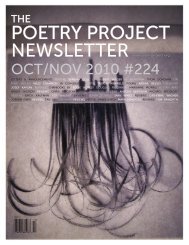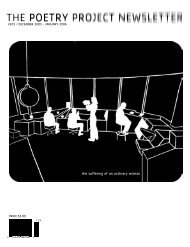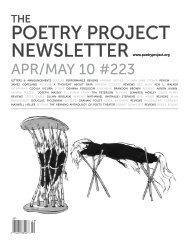Download PDF - The Poetry Project
Download PDF - The Poetry Project
Download PDF - The Poetry Project
You also want an ePaper? Increase the reach of your titles
YUMPU automatically turns print PDFs into web optimized ePapers that Google loves.
THE POETRY PROJECT NEWSLETTER<br />
23<br />
BOOK REVIEWS<br />
As such, love here is for men, women, and poems.<br />
Atkins pulls the poetry of his friend and lover<br />
into messy interfaced languages of multiple<br />
historical moments (“I won the Eurovision poetry<br />
prize in 1341”), employing a criss-crossing<br />
gang of references as company (Bach, You-<br />
Tube, Henry James, Futurism...). If there is a<br />
systemic translation methodology employed<br />
across the various, non-chronologically arranged<br />
sonnets, I have yet to discover it; the sharpness<br />
of the poems allows them to stand solidly<br />
outside of any framework, while taking place at<br />
high volume, with nerve, emotion, and wit all<br />
equally maximized. When something of a simpler<br />
yearning or sweetness breaks through, as<br />
in 339 quoted above, it can be a shock and<br />
a treat, fracturing the otherwise hyper voice<br />
of the poems. Commentary on the history of<br />
Petrarch, avant-garde predecessors, and other<br />
cultural figures are arranged throughout these<br />
poems as well, reinforcing the split-vision of a<br />
two-headed Atkins-Petrarch poet remediating<br />
the forms and figures of history as a means of<br />
finessing out an overload of feeling.<br />
Eddie Hopely’s most recent chapbooks are Cannot<br />
Contract and Hand Portraits in Steaks and Sprig.<br />
He co-curated the <strong>Poetry</strong> <strong>Project</strong> Friday Night<br />
reading series in 2009–10.<br />
We Saw the Light<br />
Daniel Kane<br />
(University of Iowa Press, 2010)<br />
review by anna moschovakis<br />
Aside from conversation, the trope Daniel Kane<br />
relies upon most in his recuperative study of<br />
poetry and the New American Cinema, We Saw<br />
the Light, is rhyme. This is fitting in a book that<br />
deftly employs a two-pronged approach to reassessing<br />
an under-studied relationship: first,<br />
by recounting the narrative transcript of the relationship<br />
between the two genres (interviews,<br />
letters, recorded conversations, unearthed<br />
correspondences); and second, with that relationship’s<br />
formal analysis, wherein similarities<br />
across mediums register as rhymes (that other<br />
sort of correspondence). <strong>The</strong> amiable way<br />
Kane leads us through the book’s seven chapters<br />
belies the fact that this book is, above all,<br />
an argument against what Kane takes to be the<br />
dominant discourse surrounding poetry’s relationship<br />
to film. Here—to adapt the well-known<br />
credo of one of its subjects, Robert Creeley—<br />
the form of Kane’s study is nothing but an extension<br />
of its argument: His book enacts the<br />
thing it calls for, a gentle but firm prying open of<br />
essentialist assumptions, rigid categorizations,<br />
and perceived incompatibilities.<br />
Take the chapters on Frank O’Hara, in which<br />
the Hollywood-entranced poet is shown to be<br />
(contra the general critical consensus) a friend<br />
of “difficult” experimental film, even something<br />
of an activist. In a reading of the Alfred<br />
Leslie/O’Hara collaboration <strong>The</strong> Last Clean<br />
Shirt, Kane argues that not only was the poorly<br />
received film—which features a mixed-race<br />
couple driving uneventfully through the streets<br />
of Manhattan in 1964—well ahead of its time<br />
aesthetically, it was also politically progressive.<br />
Far from pitting politics against joy, “O’Hara’s<br />
poetics,” Kane suggests, “connected the development<br />
of a political awareness to joy, much as<br />
Emma Goldman famously insisted on her right<br />
to dance as she staged revolution.”<br />
Close readings form the bulk of the book, with<br />
highlights including the discussion of Kenneth<br />
Anger’s Fireworks and Robert Duncan’s “<strong>The</strong><br />
Torso” in Passages, the chapter on Brakhage<br />
and Creeley, and the discussion of Warhol’s<br />
Screen Tests. Other chapters rely more on interviews,<br />
anecdotes and contextualization,<br />
such as the heartbreaking and hilarious account<br />
of the making of the Robert Frank film<br />
(featuring Allen Ginsberg and Peter Orlovsky),<br />
Me and My Brother. Everything feeds Kane’s<br />
premise, which reduces, broadly, to: If we can<br />
just set aside decades of entrenched assumptions<br />
and take a wider view of things, surprising<br />
and revealing relationships become apparent<br />
between the visionary zeal of Brakhage, the<br />
New Romanticism of the Beats; the spiritualism<br />
of Ginsberg; the pop culture of Warhol<br />
and O’Hara; the emancipatory political drive of<br />
Anger; so that we can finally talk about Warhol’s<br />
spiritualism and O’Hara’s activism and<br />
Ginsberg’s Warholian consumerism, etc. Kane<br />
acknowledges the aesthetic and political turns<br />
that prompted a movement “from an intense,<br />
even mystical subjectivity to a gloriously powerful<br />
diffuseness and play,” but rejects the singular<br />
importance of that trajectory. (He recounts a<br />
conversation with Marjorie Welish in which, in<br />
response to her suggestion that his interest in<br />
the mysticism of Anger and Duncan was “unfashionable,”<br />
he replied, “I’m interested in stories<br />
that aren’t being told anymore...What about<br />
sincere belief in God Elves Magic Can’t we<br />
appreciate that [too]”) He aims to “help us<br />
reassess how radically disjunctive forms have<br />
been used for effects antithetical to what we<br />
loosely call postmodernism.”<br />
A chapter called “<strong>The</strong> Conversations Between<br />
Andy Warhol, Gerard Malanga, Allen Ginsberg,<br />
John Ashbery, and Frank O’Hara” uses Ginsberg’s<br />
interest in the “Zen-like aspect” of Warhol’s work<br />
(wherein “ordinary objects” become “totemic”)<br />
to challenge the notion that Warhol’s “surfaceoriented”<br />
work was necessarily anathema to Ginsberg’s<br />
spiritualism. Elsewhere, Gerard Malanga<br />
becomes a double agent of contagion, via film,<br />
between the Beats and the New York School.<br />
<strong>The</strong> final close reading, of the Rudy Burkhardt/<br />
John Ashbery film Ostensibly, enacts the generative<br />
nature of collaboration by tracing, almost<br />
shot-for-shot and line-for-line, the close connection<br />
between poem and film, while locating<br />
the central refrain of both in Ashbery’s observation<br />
that there are “so many separate ways of doing.”<br />
Throughout, Kane’s selections from the<br />
numerous letters, interviews, and emails at his<br />
disposal provide great pleasure, as in the letter<br />
from Frank to Ginsberg, written during a rough<br />
patch, which ends: “We should not be afraid.<br />
Where we will differ will be at the Epilogue as I<br />
do not have the same Ideals or dreams as you<br />
have. We will make the movie and stay friends.”<br />
While gender- and genre-blurring works are<br />
in the spotlight, the gender imbalance among<br />
this study’s subjects is glaring: a glance at the<br />
index reveals inches-long lists of references for<br />
Ashbery, Brakhage, Creeley, Duncan, Ginsberg,<br />
and O’Hara, while Maya Deren nets about<br />
13 mentions, Yvonne Jacquette six, “women<br />
filmmakers and poets” five, Abigail Child one.<br />
Kane addresses the problem in his introduction,<br />
and the fact that he gives collaborators<br />
Lisa Jarnot and Jennifer Reeves the last word<br />
is less an effort to correct the balance (he could<br />
have written a different book) than an invitation<br />
for others to continue the conversation. In that<br />
interview with Jarnot and Reeves—a duo he<br />
seems to have picked in part because of their<br />
relationships to Brakhage and Duncan, but also<br />
for their comfort engaging the “unfashionable”<br />
ideas he favors—the women talk lucidly about<br />
similarities in their processes and attitudes toward<br />
their work. Kane is delighted. <strong>The</strong> rhymes<br />
are everywhere.<br />
Anna Moschovakis is teaching herself nonlinear<br />
video editing, with mixed results.<br />
Black Life<br />
Dorothea Lasky<br />
(Wave Books, 2010)<br />
review by emily pettit<br />
“Ever Read a Book Called AWE” This is the<br />
title of a poem from Dorothea Lasky’s second<br />
collection of poems, Black Life. AWE is the title<br />
of Lasky’s first collection of poems (both out
















